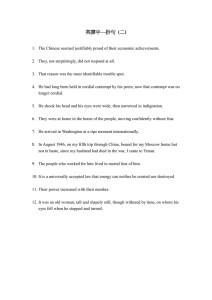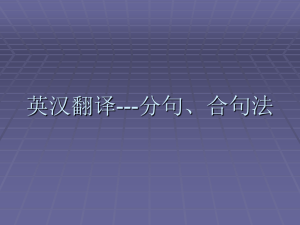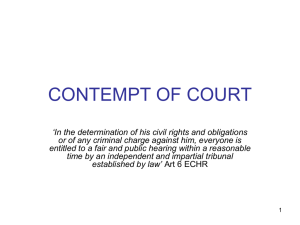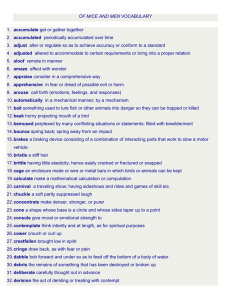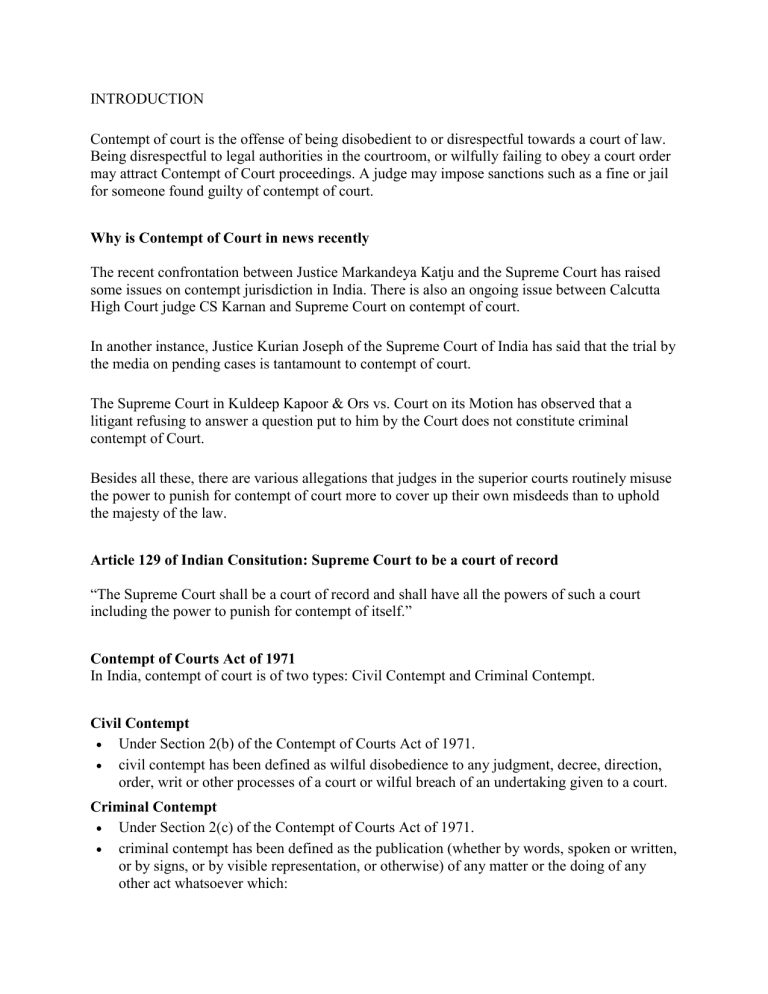
INTRODUCTION Contempt of court is the offense of being disobedient to or disrespectful towards a court of law. Being disrespectful to legal authorities in the courtroom, or wilfully failing to obey a court order may attract Contempt of Court proceedings. A judge may impose sanctions such as a fine or jail for someone found guilty of contempt of court. Why is Contempt of Court in news recently The recent confrontation between Justice Markandeya Katju and the Supreme Court has raised some issues on contempt jurisdiction in India. There is also an ongoing issue between Calcutta High Court judge CS Karnan and Supreme Court on contempt of court. In another instance, Justice Kurian Joseph of the Supreme Court of India has said that the trial by the media on pending cases is tantamount to contempt of court. The Supreme Court in Kuldeep Kapoor & Ors vs. Court on its Motion has observed that a litigant refusing to answer a question put to him by the Court does not constitute criminal contempt of Court. Besides all these, there are various allegations that judges in the superior courts routinely misuse the power to punish for contempt of court more to cover up their own misdeeds than to uphold the majesty of the law. Article 129 of Indian Consitution: Supreme Court to be a court of record “The Supreme Court shall be a court of record and shall have all the powers of such a court including the power to punish for contempt of itself.” Contempt of Courts Act of 1971 In India, contempt of court is of two types: Civil Contempt and Criminal Contempt. Civil Contempt Under Section 2(b) of the Contempt of Courts Act of 1971. civil contempt has been defined as wilful disobedience to any judgment, decree, direction, order, writ or other processes of a court or wilful breach of an undertaking given to a court. Criminal Contempt Under Section 2(c) of the Contempt of Courts Act of 1971. criminal contempt has been defined as the publication (whether by words, spoken or written, or by signs, or by visible representation, or otherwise) of any matter or the doing of any other act whatsoever which: (i) Scandalises or tends to scandalize, or lowers or tends to lower the authority of, any court, or (ii) Prejudices, or interferes or tends to interfere with the due course of any judicial proceeding, or (iii) Interferes or tends to interfere with, or obstructs or tends to obstruct, the administration of justice in any other manner. The amendment to the Contempt of Courts Act, 1971 in 2006 Neither truth nor good faith was defenses against the law of contempt in India. This was rectified only in 2006 by an amendment to the Contempt of Courts Act. The 2006 amendment to the Contempt of Courts Act, 1971 clarifies that the Court may impose punishment for contempt only when it is satisfied that substantially interferes, or tends to substantially interfere with the due course of justice. But this was not followed in the Mid-Day case, where the Delhi high court sentenced employees of the publication for contempt of court for publishing content that portrayed a retired Chief Justice of India unfavorably. Mid-Day raised the defense of truth and good faith but was not entertained. Court Cases connected with Contempt of Court in India In Duda P.N. v. Shivshankar, P., the Supreme Court observed that the contempt jurisdiction should not be used by Judges to uphold their own dignity. In the free market places of ideas, criticism about the judicial system or the Judges should be welcomed, so long as criticisms do not impair or hamper the “administration of justice”. In Auto Shankar’s Case, Jeevan Reddy J, invoked the famous “Sullivan doctrine” that public persons must be open to stringent comments and accusations as long as made with bonafide diligence, even if untrue. In Arundhati Roy, In re, the Supreme Court observed that a fair criticism of the conduct of a Judge, the institution of the judiciary and its functioning may not amount to contempt if made in good faith and in public interest. In Indirect Tax practitioners’ Association v. R.K. Jain, the S.C. observed that the Court may now permit truth as a defense if two things are satisfied, viz., (i) it is in public interest and (ii) the request for invoking said the defense is bona fide. (S.13 , Contempt of Courts Act,1971). Freedom of Speech and Expression vs Contempt of Court Article 19(1)(a) of the Constitution gives the right of freedom of speech and expression to all citizens. Articles 129 and 215 give the power of contempt of court to the higher judiciary, and this power limits the freedom granted by Article 19(1)(a). As Justice Krishna Iyer said, the law of contempt has a vague and wandering jurisdiction with uncertain boundaries. Such a law, regardless of public good, may unwittingly trample upon civil liberties. Further, the assumption that respect for the judiciary can be won by shielding judges from criticism misjudges public opinion. Surely an enforced silence, in the name of preserving the dignity of the judiciary, would cause resentment, suspicion and contempt, more than it would enhance respect. In a democracy, the people should have the right to criticize judges. The purpose of the contempt power should not be to uphold the majesty and dignity of the court but only to enable it to function. The right of the citizens to free speech and expression under Article 19(1)(a) should be treated as primary, and the power of contempt should be subordinate. What is the relevance of contempt law in a free society? The power to punish for contempt was draconian in nature without commensurate safeguards in favour of the persons charged with the accusation of having committed contempt of court. Such a power is not in consonance with the constitutional scheme of India. The basic principle in a democracy is that the people are supreme. Once this concept of popular sovereignty is kept firmly in mind, it becomes obvious that the people of India are the masters and all authorities (including the courts) are their servants. In many countries, contempt jurisdiction is regarded as archaic and exercised sparingly. In the US, courts no longer use contempt to silence comments on judges or legal matters. The First Amendment to the US Constitution forbids imposition of contempt sanctions on a newspaper. The concept of criminal contempt in India owing its origin to mid-British times was a corollary of the adage that the king could do no wrong. But this drastic power is often used by the judges in an arbitrary manner. (Note: You may read about Judicial Overreach). In a free society criticism of the judiciary is inevitable. Judges have vast powers and people will not remain silent about the exercise of such powers. Just as decisions of other branches of government attract criticism, judicial decisions would also invite the same. The test to determine whether an act amounts to contempt of court or not is this: does it make the functioning of the judges impossible or extremely difficult? If it does not, then it does not amount to contempt of court even if it is harsh criticism. The law of contempt should be employed only to enable the court to function, not to prevent criticism. It’s time for the legislature to take steps to amend the Contempt of Court Act and eschew definition of criminal contempt. Judiciary should balance two conflicting principles, ie freedom of expression, and fair and fearless justice. A mature and “broad-shouldered” approach to criticism can only inspire public confidence, not denigrate the judiciary, for justice, as Lord Atkin said, is “no cloistered virtue”. Contempt of court 1. R.k anand vs Delhi hc SC upheld the HC judgement convicting senior advocate Rk anand of contempt for attempting to influence the trail in BMW hit and run case & forfeited their right to designated as senior advocates. 2. Justice Swatantra kumar case SC warned the DG of police & commissioner of police of all state &UT of contempt action if they fail to take action on use of tinted glasses in vehicles. 3. Justice Ganguly case Apex court panel held Ganguly “prima facie guilty’’of unwelcomed conduct of sexual nature. Complainent had not joined the inquiry. Hence , no FIR was registered. 4. M.B Shanghi advocate vs P&H HC Derogatory remark by practicing advocate against judge had the effect of Scandalising the court & impairing confidence of public in general. Hence, guilty of contempt of court, Apology merely a divice to escape, not to be accepted. 5. L.P Mishra vs State of U.P L.P Mishra &others came on dias & tried to manhandle &L.P Mishra caught hold of Justice A.P Singh forcing court to rise & use abusive language against Justice B.M Lal. Court held guilty under contempt of court Act sentence to each one imprisonment of 1 month &1000 fine. 6. Arundhati Roy SC convicted Roy for having committed criminal contempt of court by scandalizing its authority with mala fide intentions .Sentence her to a symbolic imprisonment for 1 day &fine Rs.2000. 7. Sanjay Narayan editor-in-chief of HT vs Allahabad hc Court ordered for the closure of proceeding initiated against the appellants under C.O.C Act, by keeping the affidavit filed by the appelants on record, with direction to appellants to publish the apology in the first page of HT . 8. Vishvanath vs E.S Venkataramaiya Court held that the statement of former chief justice refers to only to such judges who are abusing their position, not to every judge. Petition of suo moto action for contempt was dismissed. 9. Sahara vs SEBI Court ordered for return of money of investors which was unlawfully raised by the Sahara group. 10. Justice karnan case Send a letter to PM with a list of sitting &retired HC & SC judges whom he wants ‘’interrogated’’ by investigative agencies on the ground of corruption. SC using contempt jurisdiction removed him from administrative &judicial work. 11.Dr.D.C saxena vs Chief justice of India Summary dismissal of writ petition by a judge is not violation of his oath or fundamental duties, in writ petition alleged that CJI had allowed “his son, presumably to misuse official facilities and prestige of office of CJI. Contemnor himself accepted that allegations he made was based upon the articles in newspaper& news magazine .contemnor convicted for contempt and sentenced to imprisionment of 3 months & fine Rs.3000. Contempt of court 1. R.k anand vs Delhi hc SC upheld the HC judgement convicting senior advocate Rk anand of contempt for attempting to influence the trail in BMW hit and run case & forfeited their right to designated as senior advocates. 2. Justice Swatantra kumar case SC warned the DG of police & commissioner of police of all state &UT of contempt action if they fail to take action on use of tinted glasses in vehicles. 3. Justice Ganguly case Apex court panel held Ganguly “prima facie guilty’’of unwelcomed conduct of sexual nature. Complainent had not joined the inquiry. Hence , no FIR was registered. 4. M.B Shanghi advocate vs P&H HC Derogatory remark by practicing advocate against judge had the effect of Scandalising the court & impairing confidence of public in general. Hence, guilty of contempt of court, Apology merely a divice to escape, not to be accepted. 5. L.P Mishra vs State of U.P L.P Mishra &others came on dias & tried to manhandle &L.P Mishra caught hold of Justice A.P Singh forcing court to rise & use abusive language against Justice B.M Lal. Court held guilty under contempt of court Act sentence to each one imprisonment of 1 month &1000 fine. 6. Arundhati Roy SC convicted Roy for having committed criminal contempt of court by scandalizing its authority with mala fide intentions .Sentence her to a symbolic imprisonment for 1 day &fine Rs.2000. 7. Sanjay Narayan editor-in-chief of HT vs Allahabad hc Court ordered for the closure of proceeding initiated against the appellants under C.O.C Act, by keeping the affidavit filed by the appelants on record, with direction to appellants to publish the apology in the first page of HT . 8. Vishvanath vs E.S Venkataramaiya Court held that the statement of former chief justice refers to only to such judges who are abusing their position, not to every judge. Petition of suo moto action for contempt was dismissed. 9. Sahara vs SEBI Court ordered for return of money of investors which was unlawfully raised by the Sahara group. 10. Justice karnan case Send a letter to PM with a list of sitting &retired HC & SC judges whom he wants ‘’interrogated’’ by investigative agencies on the ground of corruption. SC using contempt jurisdiction removed him from administrative &judicial work. 11.Dr.D.C saxena vs Chief justice of India Summary dismissal of writ petition by a judge is not violation of his oath or fundamental duties, in writ petition alleged that CJI had allowed “his son, presumably to misuse official facilities and prestige of office of CJI. Contemnor himself accepted that allegations he made was based upon the articles in newspaper& news magazine .contemnor convicted for contempt and sentenced to imprisionment of 3 months & fine Rs.3000. Contempt of court 1. R.k anand vs Delhi hc SC upheld the HC judgement convicting senior advocate Rk anand of contempt for attempting to influence the trail in BMW hit and run case & forfeited their right to designated as senior advocates. 2. Justice Swatantra kumar case SC warned the DG of police & commissioner of police of all state &UT of contempt action if they fail to take action on use of tinted glasses in vehicles. 3. Justice Ganguly case Apex court panel held Ganguly “prima facie guilty’’of unwelcomed conduct of sexual nature. Complainent had not joined the inquiry. Hence , no FIR was registered. 4. M.B Shanghi advocate vs P&H HC Derogatory remark by practicing advocate against judge had the effect of Scandalising the court & impairing confidence of public in general. Hence, guilty of contempt of court, Apology merely a divice to escape, not to be accepted. 5. L.P Mishra vs State of U.P L.P Mishra &others came on dias & tried to manhandle &L.P Mishra caught hold of Justice A.P Singh forcing court to rise & use abusive language against Justice B.M Lal. Court held guilty under contempt of court Act sentence to each one imprisonment of 1 month &1000 fine. 6. Arundhati Roy SC convicted Roy for having committed criminal contempt of court by scandalizing its authority with mala fide intentions .Sentence her to a symbolic imprisonment for 1 day &fine Rs.2000. 7. Sanjay Narayan editor-in-chief of HT vs Allahabad hc Court ordered for the closure of proceeding initiated against the appellants under C.O.C Act, by keeping the affidavit filed by the appelants on record, with direction to appellants to publish the apology in the first page of HT . 8. Vishvanath vs E.S Venkataramaiya Court held that the statement of former chief justice refers to only to such judges who are abusing their position, not to every judge. Petition of suo moto action for contempt was dismissed. 9. Sahara vs SEBI Court ordered for return of money of investors which was unlawfully raised by the Sahara group. 10. Justice karnan case Send a letter to PM with a list of sitting &retired HC & SC judges whom he wants ‘’interrogated’’ by investigative agencies on the ground of corruption. SC using contempt jurisdiction removed him from administrative &judicial work. 11.Dr.D.C saxena vs Chief justice of India Summary dismissal of writ petition by a judge is not violation of his oath or fundamental duties, in writ petition alleged that CJI had allowed “his son, presumably to misuse official facilities and prestige of office of CJI. Contemnor himself accepted that allegations he made was based upon the articles in newspaper& news magazine .contemnor convicted for contempt and sentenced to imprisionment of 3 months & fine Rs.3000. A question is often asked, can action for Criminal Contempt of Court and Criminal Defamation, be initiated simultaneously. A tricky question, the answer of which will depend upon the facts and circumstances of each case. In order to understand the nuances between Criminal Contempt of Court and Criminal Defamation, it is necessary to understand the concept of criminal contempt of Court and criminal defamation, as provided under the Indian Laws and the precedents. Under The Contempt of Courts Act, 1971, the definition of criminal contempt of Court has been provided under Section 2(c), which states as under: "Criminal contempt" means the publication (whether by words, spoken or written, or by signs, or by visible representation, or otherwise) of any matter or the doing of any other act whatsoever which1. Scandalizes or tends to scandalize, or lowers or tends to lower the authority of, any court, or 2. Prejudices, or interferes or tends to interfere with the due course of any judicial proceeding , or 3. Interferes or tends to interfere with, or obstructs or tends to obstruct, the administration of justice in any other manner." The principle and purpose of the Contempt Law is to maintain and uphold the dignity and respect of the Courts, in the eyes of the public and to deter men from offering any indignities to a court of justice. Therefore, if any person makes any statement (written or spoken) which tends to obstruct the administration of justice or scandalizes or lower the authority of any Court, it will amount to criminal Contempt of Court. The definition of criminal contempt includes within its folds remarks and allegations made against judges. The rationale behind this is that it raises questions about the integrity and authority of the judiciary and thus obstructs public confidence in it as an institution, thereby disrupting the administration of justice. The law of contempt is intended to preserve the authority of the judicial process, judiciary and the Courts reputation. In the case of Delhi Judicial Service Association, Tis Hazari Court, Delhi v. State of Gujarat and Ors., MANU/SC/0478/1991: 1991CriLJ3086, a three Judge Bench of the Hon'ble Supreme Court observed as under: "The definition of criminal contempt is wide enough to include any act by a person which would tend to interfere with the administration of justice or which would lower the authority of court. The public have a vital stake in effective and orderly administration of justice. The Court has the duty of protecting the interest of the community in the due administration of justice and, so, it is entrusted with the power to commit for contempt of court, not to protect the dignity of the Court against insult or injury, but, to protect and vindicate the right of the public so that the administration of justice is not perverted, prejudiced, obstructed or interfered with." The definition of Defamation has been provided under Section 499 of the Indian Penal Code, 1860: "Defamation.邑hoever, by words either spoken or intended to be read, or by signs or by visible representations, makes or publishes any imputation concerning any person intending to harm, or knowing or having reason to believe that such imputation will harm, the reputation of such person, is said, except in the cases hereinafter expected, to defame that person. First Exception.悠mputation of truth which public good requires to be made or published. Second Exception.猶ublic conduct of public servants. Third Exception.佑onduct of any person touching any public question. Fourth Exception.猶ublication of reports of proceedings of Courts. Fifth Exception.柚erits of case decided in Court or conduct of witnesses and others concerned." The aim and purpose of law of Criminal Defamation, on the other hand, is to prevent the person from maligning or harming the reputation of other person, with malafide intentions, as right to reputation is an important facet of right to life guaranteed under Article 21 of the Constitution of India. To constitute the offence of criminal defamation, there has to be imputation and it must have made in the manner as provided in the provision with the intention of causing harm or having reason to believe that such imputation will harm the reputation of the person about whom it is made. Causing harm to the reputation of a person is the basis on which the offence is founded and mens rea is a condition precedent to constitute the said offence. In Jeffrey J. Diermeier and Anr. Vs. State of West Bengal and Anr., MANU/SC/0390/2010:(2010) 6 SCC 243, a two-Judge Bench of the Hon'ble Supreme Court deliberated on the aspect as to what constitutes defamation Under Section 499 of Indian Penal Code and in that context, held that there must be an imputation and such imputation must have been made with the intention of harming or knowing or having reason to believe that it will harm the reputation of the person about whom it is made. In essence, the offence of defamation is the harm caused to the reputation of a person. It would be sufficient to show that the accused intended or knew or had reason to believe that the imputation made by him would harm the reputation of the complainant, irrespective of whether the complainant actually suffered directly or indirectly from the imputation alleged. Recently, the Hon'ble Supreme Court in the case of, Dr. Subramanian Swamy vs. Union of India (UOI), Ministry of Law and Ors., MANU/SC/0621/2016, has upheld the constitutional validity of the criminal defamation under the provisions of Sections 499 and 500 Indian Penal Code, 1860. The action for criminal defamation can be initiated by an aggrieved person against the accused, whereas for contempt of Court, action can be initiated suo moto by Supreme Court or High Court, or on a motion made by the Advocate-General/ Law Officer, or on a reference made to High Court by the subordinate court, as the case may be. The Constitutional Bench of the Hon'ble Supreme Court while deciding the case titled as Brahma Prakash Sharma and Ors. Vs. The State of Uttar Pradesh, MANU/SC/0020/1953, held that: "The position therefore is that a defamatory attack on a judge may be a libel so far as the judge is concerned and it would be open to him to proceed against the libelor in a proper action if he so chooses. If, however, the publication of the disparaging statement is calculated to interfere with the due course of justice or proper administration of law by such court, it can be punished summarily as contempt. One is a wrong done to the judge personally while the other is a wrong done to the public. It will be an injury to the public if it tends to create an apprehension in the minds of the people regarding the integrity, ability or fairness of the judge or to deter actual and prospective litigants from placing complete reliance upon the court's administration of justice, or if it is likely to cause embarrassment in the mind of the judge himself in the discharge of his judicial duties. It is well established that it is not necessary to prove affirmatively that there has been an actual interference with the administration of justice by reason of such defamatory statement; it is enough if it is likely, or tends in any way, to interfere with the proper administration of law" The Hon'ble Supreme Court in the case of In Re: S. Mulgaokar, AIR1978SC727: MANU/SC/0067/1977, observed as under: "The third principle is to avoid confusion between personal protection of a libeled judge and prevention of obstruction of public justice and the community's confidence in that great process. The former is not contempt, the latter is, although overlapping spaces abound. 30. Because the law of contempt exists to protect public confidence in the administration of justice, the offence will not be committed by attacks upon the personal reputation of individual judges as such. As Professor Good hart has put it: Scandalising the court means any hostile criticism of the " judge as judge; any personal attack upon him, unconnected with the office he holds, is dealt with under the ordinary rules of slander and libel. Similarly, Griffith, C. J. has said in the Australian case of Nicholls (1911) 12 C.L.R. 280 that: In one sense, no doubt, every defamatory publication concerning a judge may be said to bring him into contempt as that term is used in the law of libel, but it does not follow that everything said of a judge calculated to bring him into contempt in that sense amounts to contempt of Court." The Supreme Court in the case of Bathina Ramakrishna Reddy v. State of Madras, AIR1952SC149: MANU/SC/0074/1952, stated as under: "A libelous reflection upon the conduct of a judge in respect of his judicial duties may certainly come under section 499 of the Indian Penal Code and it may be open to the judge to take steps against the libeler in the ordinary way for indication of his character and personal dignity as a judge; but such libel may or may not amount to contempt of court. As the Privy Council observed in Surendra Nath Banerjee v. The Chief Justice and Judges of the High Court,I.L.R. 10 Cal. 109 "although contempt may include defamation, yet an offence of contempt is something more than mere defamation and is of a different character". (The aforesaid case has been overruled by the Hon'ble Supreme Court but the above observation was left untouched.) Further, the Hon'ble Supreme Court in the case of Haridas Das vs. Smt. Usha Rani Banik and Ors. and Apu Banik, MANU/SC/3005/2007, observed that though certain imputations against the Judge may be only libelous against that particular individual, it may at times amount to contempt also depending upon the gravity of the allegations, therefore, apart from the fact that a particular statement is libelous, it can constitute criminal contempt if the imputation is such that the same is capable of lowering the authority of the Court. The gravity of the aforesaid statement is that the same would scandalize the court. From the above, it is clear that the contempt of court jurisdiction is not exercised to protect the dignity of an individual Judge, but to protect the administration of justice from being maligned and with respect to a defamatory attack on a Judge is concerned, it would be open to him to proceed against the libeler in a proper action, if he so chooses. Judiciary is an indispensable tier in the administration of justice. Judiciary has Special role in the society. It deserves protection against baseless criticisms against itself. Thus, although defamatory allegations made against a judge may constitute contempt of court, the two are still distinguishable. The presence and extent of mens rea will play an important role in determining that whether the offence of defamation or the Contempt of Court is criminal or not. That since these two concepts coincide, it is possible to initiate proceedings for both where the facts of case allow, and when the effects of the act committed overlap in that regard. Thus, the facts that constitute defamation may amount to contempt of court as well in certain situations. Hence, there can be simultaneous proceedings of Criminal Defamation and Criminal Contempt of Court, considering the facts of each case.
